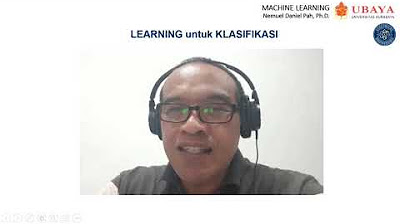StatQuest: Logistic Regression
Summary
TLDRIn this episode of StatQuest, host Josh Starmer introduces logistic regression, a machine learning technique for predicting binary outcomes like obesity in mice. Unlike linear regression, logistic regression uses an S-shaped curve to estimate probabilities and classify results, accommodating both continuous and discrete data. The episode explains the process of fitting the model using maximum likelihood instead of least squares and highlights the importance of variable testing to determine predictive usefulness, showcasing the method's versatility and applicability in statistical analysis.
Takeaways
- 📈 Linear Regression Basics: The script starts with a review of linear regression, explaining how it can be used to predict continuous variables like size based on weight.
- 🔍 R-Squared and P-Value: It discusses how r-squared measures correlation and p-values determine the statistical significance of the model.
- 🤖 Machine Learning Connection: Linear regression is highlighted as a form of machine learning, used for prediction and modeling.
- 📊 Multiple Regression: The script explains how multiple regression extends linear regression to include more variables like weight and blood volume.
- 🔬 Genotype as a Discrete Predictor: It mentions the use of discrete data like genotype in regression models to predict outcomes like mouse size.
- 🔄 Model Comparison: The importance of comparing simple and complex models to determine the necessity of additional variables is discussed.
- 🔑 Introduction to Logistic Regression: The script introduces logistic regression as a technique for predicting binary outcomes, like whether a mouse is obese or not.
- 📉 S-shaped Logistic Function: Logistic regression fits an S-shaped curve to the data, which represents the probability of an event occurring based on the input variables.
- 🎯 Classification Use: It clarifies that logistic regression is often used for classification, such as classifying mice as obese based on a probability threshold.
- 🔍 Variable Utility Testing: The script mentions testing variables for their utility in prediction using Wald's tests, which will be explained in another StatQuest episode.
- 🧠 Maximum Likelihood Method: Logistic regression uses the maximum likelihood method instead of least squares to fit the model to the data, differing from linear regression.
- 🌟 Popularity in Machine Learning: The script concludes by emphasizing logistic regression's popularity in machine learning for its ability to handle both continuous and discrete data for classification and variable assessment.
Q & A
What is the main topic discussed in this StatQuest video?
-The main topic discussed in this StatQuest video is logistic regression, a statistical technique used for both traditional statistics and machine learning.
What is the purpose of logistic regression?
-Logistic regression is used to predict the probability of a binary outcome, such as whether something is true or false, and is commonly used for classification tasks.
How does logistic regression differ from linear regression in terms of the outcome it predicts?
-Linear regression predicts continuous outcomes, like weight or size, whereas logistic regression predicts the probability of a binary outcome, such as whether a mouse is obese or not.
What type of function does logistic regression fit to the data?
-Logistic regression fits an S-shaped logistic function to the data, which ranges from zero to one and represents probabilities.
How does logistic regression classify new samples based on the probability of the outcome?
-Logistic regression classifies new samples by setting a threshold, typically 50%. If the probability of the outcome is greater than the threshold, the sample is classified as belonging to one category; otherwise, it belongs to the other.
What are some examples of variables that can be used in logistic regression models?
-Examples of variables that can be used in logistic regression models include continuous data like weight and age, as well as discrete data like genotype and astrological sign.
How does logistic regression handle the comparison of simple and complex models?
-Unlike linear regression, logistic regression does not use residuals or R-squared to compare models. Instead, it tests each variable's effect on the prediction using Wald's tests to determine if it significantly contributes to the model.
What statistical method does logistic regression use to fit the curve to the data?
-Logistic regression uses maximum likelihood estimation to fit the curve to the data, which involves finding the parameters that maximize the likelihood of observing the given data.
Why might a variable be considered 'useless' in a logistic regression model?
-A variable might be considered 'useless' in a logistic regression model if its effect on the prediction is not significantly different from zero, indicating that it does not help in predicting the outcome.
How can the video script help someone who is unfamiliar with the term 'genotype'?
-The script reassures viewers that they do not need to be concerned about unfamiliar terms like 'genotype', explaining that it simply refers to different types of mice in the context of the example provided.
What does the script suggest about the usefulness of astrological signs in logistic regression models?
-The script humorously suggests that astrological signs are 'totes useless' in logistic regression models, implying that they do not contribute to the predictive power of the model.
Outlines

Esta sección está disponible solo para usuarios con suscripción. Por favor, mejora tu plan para acceder a esta parte.
Mejorar ahoraMindmap

Esta sección está disponible solo para usuarios con suscripción. Por favor, mejora tu plan para acceder a esta parte.
Mejorar ahoraKeywords

Esta sección está disponible solo para usuarios con suscripción. Por favor, mejora tu plan para acceder a esta parte.
Mejorar ahoraHighlights

Esta sección está disponible solo para usuarios con suscripción. Por favor, mejora tu plan para acceder a esta parte.
Mejorar ahoraTranscripts

Esta sección está disponible solo para usuarios con suscripción. Por favor, mejora tu plan para acceder a esta parte.
Mejorar ahora5.0 / 5 (0 votes)






